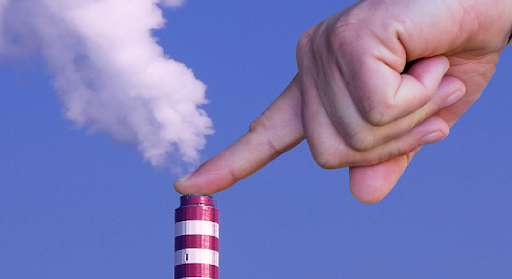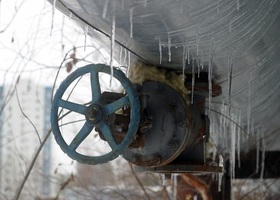The Decarbonization Fund for reduction of СО2 emissions: an effect worth 5 billion hryvnias
Is reduction of emissions worth spending carbon tax revenues?

The Decarbonization Fund proposed by the Energy Ministry of Ukraine may allocate a half of carbon tax revenues for environmental purposes. Critics of the ministry’s initiative believe that taking funds away from other socially important budget items to spend them on this purpose is not worth the while: it looks like economic and environmental consequences of the creation of this Fund do not seem to be of a priority importance to some.
But in fact, the Fund is only an instrument for targeted spending of taxpayer money, which does not need additional administrative expenses. To be sure, it somewhat resembles the “warm loans” for households: an enterprise takes out a loan to finance environmental modernization, and the government helps pay the loan principal.
Ukrainian Energy looked into details and tried to find out how the country would benefit from establishing this Fund.
The Decarbonization Fund: a model that does not envisage a new legal entity
The Energy Ministry, the State Agency for Energy Efficiency and Energy Conservation and the Ukrainian-Danish Energy Center initiated establishment of a decarbonization fund, and soon, the relevant draft law was registered in the Verkhovna Rada. According to Deputy Energy Minister Yaroslav Demchenkov, the proposed initiative envisages creation of a separate item, “decarbonization fund”, in the 2021 state budget. The idea is to spend a portion of СО2 emission tax on projects aimed to reduce carbon dioxide emissions. In fact, this is an initiative of targeted spending, because presently, carbon tax revenues are not allocated for any specific purposes and remitted to the general fund of the state budget. Therefore, the decarbonization fund does not envisage establishment of a separate legal entity. The Deputy Minister cited as similar examples Ukraine’s State Fund for Regional Development or State Road Fund.
“It is a justifiable model when the process of administering does not necessitate additional expenditures from the state budget and can be carried out by the existing government institutions,” Mr. Demchenkov explained. According to him, the decarbonization fund must be administered by the State Agency for Energy Efficiency and Energy Conservation, which over time will turn into an agency of “green” energy.
“The government’s desire to avoid establishing new institutions and incurring additional administrative expenditures from the state budget is a plus,” DIXI Group analyst Daryna Kulaha said.
The Head of the State Agency for Energy Efficiency and Energy Conservation, Kostiantyn Hura, classed the creation of a decarbonization fund as an investment. “This initiative is not a spending but a government investment in energy efficiency, which in turn, gives a boost to the economy,” Acting Chairman of the State Agency for Energy Efficiency and Energy Conservation said.
According to Energy Minister Olha Buslavets, the creation of a decarbonization fund would help reduce the carbon footprint of Ukrainian products, thus allowing to lower the “carbon tariff” which the EU may introduce the next year. “This fund will help Ukraine achieve in practice a mutually beneficial partnership with EU states in the area of sustainable development and implementation of the Green Deal, whose goals we want to realize here as well,” the head of the Energy Ministry said when speaking before the parliamentarians.
“Unless Ukraine makes its economy more climatically neutral and implements energy efficiency measures, our goods, including electricity, will be economically uncompetitive in the European and other markets,” Deputy Energy Minister Yaroslav Demchenkov said.
5 billion for decarbonization already the next year is real
“According to the Finance Ministry’s estimates, the allocation of 50% of carbon dioxide emission tax to this fund will allow to concentrate 1.35 billion hryvnias,” Mr. Demchenkov said. According to him, co-financing envisages the 3.5 multiplier of government investments; therefore, investments in decarbonization projects in 2021 will reach UAH 4.7 billion.
“The concept of spending moneys from the state decarbonization fund envisages solely reimbursements of a portion of the loan principal borrowed by a business entity to implement decarbonization measures,” the Deputy Minister emphasized. “It envisages reimbursement of up to 30% of the loan principal for borrowers – payers of СО2 tax and up to 25% for nonpayers. The remaining portion (70-75%) is a loan to enterprises implementing measures of reducing the carbon footprint.” Mr. Demchenkov explained that these loans could be repaid from the enterprises’ own working capital or with the support from the local budgets, if these enterprises have communal form of ownership.
The amount of investments could be even greater if they are co-financed by the EU and from local decarbonization programs. Therefore, the net additional effect from tax revenues to the state budget’s general fund, if moneys are spent on the basis of the co-financing principle, is expected to be some 1.95 billion hryvnias.
“Presently, the budget receives UAH 0.9 billion in carbon tax revenue (based on the rate of 10 hryvnias per ton of СО2),” Mr. Demchenkov explained. “We hope that if our initiative is supported by MPs, we will have up to UAH 1.5 billion per year to support these measures.” It is worth reminding that the registered draft law 4347 envisages, in particular, the raise of carbon tax rate from 10 to 30 hryvnias per ton.
“If this precedent is set, the use of moneys from this fund will bring in additional moneys,” Mr. Demchenkov explained. The Deputy Minister also emphasized that in today’s conditions of global warming the issue is not just the money but also reduction of СО2 emissions as such. “We calculated that the application of this instrument may result in the reduction of emissions by up to 20%,” the Deputy Minister said. He explained that to assess the results of spending the allocated moneys, they will hold energy audits and take energy and environmental management actions.
“The averaged expected indicator of СО2 emission reduction concerns solely the object of modernization,” the Deputy Minister explained. “The reduction of carbon dioxide emissions will be verified according to the verification procedure which the government must approve. The calculation will compare the volume of emissions from a particular plant before and after the implementation of measures. Therefore, we expect the carbon footprint to be reduced by up to 20% for every generating facility receiving support from the Decarbonization Fund.”
According to DiXi Group expert Daryna Kulaha, the Energy Ministry’s proposal is, overall, a step in the right direction, because it has the purpose of spending the greenhouse gas emission charge on reducing those very emissions, thus stimulating the transition to the “green” economy. “However, this amount is critically low to cause any systemic shifts toward decarbonization of the economy,” the expert believes. She emphasizes that the Fund could play an important role in implementing the National Emission Reduction Plan, but the amount of capital investments required to fulfil the plan may reach 4.13 billion euros by 2034.
“In other words, ecological modernization of heat and power generating plants needs huge outlays,” Daryna Kulaha summarizes. “If UAH 1.35 billion is divided among the seven project areas, it would be enough only for small targeted projects.” She believes that the amount of the Fund’s revenues can be increased, firstly, by allocating the full amount of carbon tax remittances to it, and secondly, by raising the rate of the tax itself.
The Decarbonization Fund may become operational already in 1Q 2021
Answering the question from Ukrainian Energy about how long it may take to implement this initiative in Ukraine, the Deputy Minister explained that if MPs vote in support of establishing the Fund during this budget process, the Fund will become operational in the nearest future. “We have already prepared all the necessary formulas and materials for that,” he said. “This fund is not something new – it operates in eighteen different countries.” The Danish government helped Ukraine with preparing calculations for the decarbonization fund.
“If the parliament supports our initiative, the government will adopt a resolution setting forth the procedure of allocating these funds and we will immediately start explaining banks, companies, etc. how they can tap into these opportunities,” Mr. Demchenkov said. “Therefore, this instrument may become operational already in the first quarter of the next year.”
What the Decarbonization Fund’s moneys will be spent on, first of all
“The key areas of allocating the Decarbonization Fund’s moneys will include not only energy efficiency projects but also modernization of heat and water supply networks and outdoor lighting, projects aimed to cheapen domestic waste utilization, stimulate the use of electric buses and electric cars, reduce the use of conventional fuels in the public sector, stimulate the use of bioethanol and biogas, and develop the global trend of hydrogen power,” Mr. Demchenkov said.
According to the Deputy Minister, out of the seven areas on which carbon tax revenues are going to be spent, enterprises paying carbon dioxide emission tax will be considered first of all. Moneys will be provided to these enterprises by refunding a portion of bank loans taken out for energy modernization and СО2 emission reduction projects. “The list of banks will not contain limitations, featuring Ukrainian banks regardless of the form of ownership and international financial institutions,” Mr. Demchenkov said. He further emphasized that bureaucrats won’t have a say in the financing process, which should mitigate corruption risks. “It will be solely a check by banks of the conformity with criteria and of the procedure of spending funds,” he said.
It is worth noting that there will be a percentage of refund set in accordance with requirements of antimonopoly law, as well as a cap on the refund amount, the Head of the State Agency for Energy Efficiency and Energy Conservation, Kostiantyn Hura, told Ukrainian Energy. “It will allow a large number of enterprises to tap into the Fund, and make it impossible to use the Fund’s moneys by one enterprise,” he said. “It is expected that the first applicants will be the enterprises which already have an energy management system or underwent an energy audit, because that’s the most important condition for the issuance of loans.”
Therefore, the State Agency for Energy Efficiency and Energy Conservation emphasized, the main mechanism of the Decarbonization Fund will feature a refund of a portion of bank loans taken out by enterprises for energy modernization and СО2 emission reduction projects.
How the Fund’s moneys will work
To explain how it will work, the government official cited the following example. An enterprise has decided to make an energy efficient modernization: replace a boiler. It applies to a commercial bank participating in the Decarbonization Fund’s program and receives 100 million hryvnias to finance the purchase. The applicant buys a boiler and sends the purchase documents to the bank, and the bank forwards them to the State Agency for Energy Efficiency and Energy Conservation. The agency verifies the reduction of emissions and ok’s the bank to refund 30% of the loan amount. The percentage may vary depending on the reduction volume of greenhouse gas emissions. The commercial bank will then inform the enterprise that their loan obligations have been reduced by 30 million hryvnias. Therefore, the enterprise will receive a boiler worth 100 million for 70 million hryvnias.
“Our ministry has developed a scale according to which the moneys will be disbursed among enterprises,” Mr. Demchenkov said. “The enterprises paying СО2 tax will have the preference.” Enterprises paying carbon tax will get a refund of 30% of the loan principal, and the non-payers will get 20-25%, depending on project and the emission reduction volume.
A political will is needed to stop the “dilution” of carbon tax in the budget
According to Yaroslav Demchenkov, a political will of parliamentarians is needed to implement the ministry’s ambitious plans. When it comes to the allocation of a portion of carbon tax revenues for the aforementioned purposes, there will always be somebody saying that it’s better to spend this money on roads, or on combating COVID-19, or on something else.
“When carbon tax is remitted to the budget, it gets diluted, and in the end, it is hard to tell what exactly these moneys were spent on,” the Deputy Minister said. “However, experience proves that unfortunately, these moneys aren’t spent on environmental protection or energy efficiency, which is very important for our goals.”
On 9 November, a draft Law amending the Budget Code by introducing the decarbonization fund was registered in the parliament. This draft law was initiated by MP Yuri Kamelchuk. The document is currently being reviewed by parliamentary committees. Yuri Kamelchuk believes that members of the parliament will vote in support for this draft law. “The talks with the committee are slated for today (13 November – editor’s note), and decision can be made in the nearest weeks,” the parliamentarian commented.








